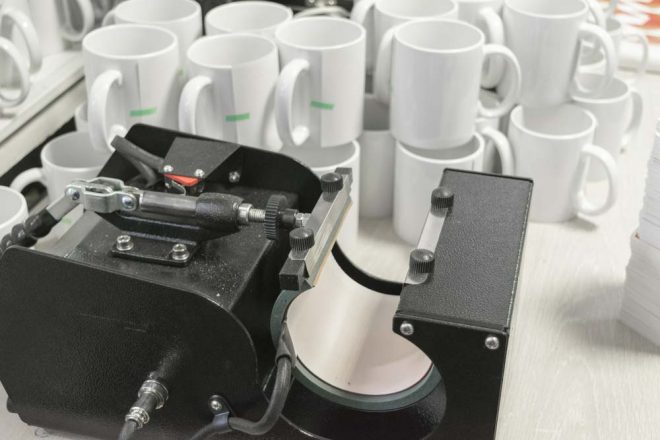
If you’ve spent any time online, you’ve likely come across advertisements for personalized shirts, coffee mugs, mousepads, and more. Or, if you’ve ever passed storefronts while walking around town, you’ve likely noticed large, vibrant banners and posters advertising the wares inside. All of these things have one important thing in common: they were likely created with sublimation printing.
In this post, we will cover everything you need to know about sublimation printing, from what it is and how it works to how you can start your own sublimation printing business today.
Contents
What is Sublimation Printing?
Sublimation printing, also known as dye sublimation printing, is the process of transferring dyes onto fabrics and other materials. Sublimation printers are known for creating crisp, vibrant, high-resolution prints that won’t fade over time. They are used for most graphic apparel, home décor, and advertising displays.
So what is sublimation? And what makes it different from other printing?
Sublimation is a scientific term that refers to the chemical process of a solid material transferring into a gaseous phase without first passing through an intermediary liquid phase. This means that during sublimation printing, the ink never reaches a liquid phase. Without a liquid phase, you don’t have to give the liquid time to dry, and you don’t run the risk of the image shifting or smudging.
The solid sublimation ink is transferred to the sublimation paper via the printer, and then the paper is placed on the final object. Heat (350 to 400o Fahrenheit) and pressure from a heat press are applied to the solid ink for a set amount of time, which causes the ink to transform into a gaseous state and penetrate the pores of the object. Once the ink has melded into the object, it once again solidifies, leaving a vibrant, high-resolution print.
Breakdown of Sublimation Printing
Like any printing process, sublimation printing has both benefits and downsides:
| Benefits | Downsides |
|---|---|
| Creates vibrant, high-resolution prints. | Expensive startup cost to purchase all the necessary components (discussed below). |
| Prints don’t degrade, making it perfect for items that are used or washed frequently, such as shirts, sheets, and kitchenware. | Ghosting can occur if your sublimation paper moves during the heat press transfer. |
| Prints don’t degrade, making it perfect for items that are used or washed frequently, such as shirts, sheets, and kitchenware. | Does not have white ink, so it cannot be completed on dark fabrics or surfaces. |
| Can be done quickly and efficiently. |
Sublimation Printing vs. Inkjet and Laser Printing
To understand the difference between sublimation printing and inkjet or laser printing, think about your current home or office printer.
If you have an inkjet printer, your printer ink is a liquid that is stored in cartridges. You likely know it is a liquid because you’ve gotten it on your hands or clothing when changing the cartridges (if that’s the case, we have solutions available on our Get Printer Ink off of Hands & Clothing article).
When you print with Inkjet printers, the printer heads deposit ink onto the piece of paper. If you touch the paper too soon after printing, the ink may still be wet, and you can smudge the graphic.
If you have a laser printer, your ink is stored as a powder called “toner.” The toner is heated by a fuser unit during the printing process and turned into a liquid. This liquid is then deposited on the paper, similar to the inkjet printer.
Both inkjet and laser printers deposit liquid ink as a layer on the paper. While the first step of sublimation printing is similar, the ink is transferred as a solid, meaning it never truly reaches that liquid state. Sublimation printing then takes the process one step further by using a heat press to transfer the image into the chemical structure of the final object. While the outside of the printer might look the same, both the process and the ink are distinct in sublimation printing.
Top Uses for Sublimation Printing
Sublimation printing can be utilized to create vibrant images on hundreds of different types of objects. Some of the most common uses of sublimation printing include:
- Rigid Substrates: Non-fabric items that don’t easily bend, such as glass, plastic, fiberglass, and aluminum, tend to work well for sublimation. Common examples include drinkware and cellphone cases. This also includes home décor, such as ceramic tiles for kitchens and bathrooms.
- Signs and Banners: Most of the advertisements you see in stores are created by sublimation printers. This ensures that they are professionally printed and don’t fade with sunlight and time.
- Polyester, Nylon, and Spandex Fabrics: This includes apparel, banners, flags, tote bags, tents, and more. Unfortunately, sublimation printing doesn’t work on other fabrics, such as cotton, because the sublimation ink can pass through the fabric without forming a chemical bond.
- Photographs: Sublimation printing is the best way to create high-resolution photographs on paper or canvas.
Unfortunately, sublimation printing cannot be completed on just any material. Sublimation materials must be able to bond with the ink and withstand the high temperatures of the heat press. As a result, most final objects in the sublimation process are plastic or plastic-based products. However, certain metals and fabrics can also be used.
If you are concerned about getting items that can be successfully used with sublimation printers, it’s easiest to simply purchase items that are labeled “sublimation-ready.”
The Components of Sublimation Printing
Sublimation printing includes more than just a printer. To start your sublimation printing, you will require the following items:
- Sublimation Printer: For the best sublimation printers on the personal and business markets, see our article on Best Sublimation Printer.
- Sublimation or Transfer Paper: Sublimation printers transfer the image to the sublimation paper before it is applied to the final object. Sublimation paper is a special composite blend that is less absorbent than standard printer paper. It is imperative to use sublimation paper because it both holds the image successfully and can withstand the heat of the heating press.
- Computer and Raster Image Processor (RIP): Like most printers, the sublimation printer will need to be connected to a computer to print. The computer must come with compatible RIP software. Most sublimation printers come with the RIP software. If your printer does not, you will need to purchase it separately.
- Heat Press: The heat press removes the design from the sublimation paper and transfers it to the final object. The type of heat press you should purchase is determined by the type of sublimation printing you will complete.
- Sublimation Tape or Spray-on Adhesive: Once the image has been printed onto the sublimation paper, a heat press is used to transfer the image to the final object. If the sublimation paper moves during the heating process, it can cause blurring or ghosting in the image. Sublimation tape and spray-on adhesive can be used to hold the sublimation paper in place without melting or leaving a residue when exposed to heat and pressure. Do not try to use standard masking tape, or you will be left with a sticky, smelly mess.
In addition to the items listed above, the following items are highly recommended (despite not being required):
- Gloves: When you remove items from the heat press, they are going to be understandably hot. Heat-resistant gloves are a great way to ensure that you don’t burn your fingers. If you are purchasing gloves, we’d recommend wool or leather work gloves rather than plastic gloves, as plastic gloves can leave a residue on certain sublimation objects.
- Lint Roller: If you are sublimation printing onto fabrics, a lint roller is important. If there is fuzz or lint on your fabric when you complete your sublimation, it can block the ink from reaching the base fabric, leaving your image with small un-colored holes.
- Cutting Mechanism: If your sublimation paper is larger than your object, you may need to cut it down to fit before the transfer process is completed. If you are working with canvas, fabric, or paper, you may be required to cut your final object once the sublimation is complete. It is important to have the proper tools to cut your paper and fabrics to ensure you don’t ruin your design or your final object.
A Step-by-Step Guide to Sublimation Printing
Once you have the proper components for sublimation printing, it is then time to print. To complete your sublimation printing, you can follow these simple steps:
- Print your image onto the sublimation paper (following printer manufacturer instructions).
- Cut out the image (as necessary) and secure the sublimation paper to your final object.
- Put the object into the heat press and set the time and temperature based on the heat press instructions.
- Remove the object from the heat press (carefully- it’s hot) and remove the sublimation paper.
- Enjoy your beautiful sublimation object.
Additional FAQs
Can I use regular paper instead of sublimation paper?
- Unfortunately not. Sublimation paper is a special type of paper that captures the sublimation ink and properly transfers it to the final object.
Can I use my printer for both sublimation and inkjet printing?
- Once you utilize a printer for sublimation printing, it cannot be utilized for inkjet printing again.
Can any printer do sublimation printing?
- Sublimation printing requires a printer that can accommodate both sublimation ink and paper. Printers with piezo printing technology can typically be converted to sublimation printing; printers with thermal printing technology cannot.
What is the difference between heat transfer and sublimation printing?
- Heat transfer printing lays the ink in a coat on top of the object; it does not fuse the ink with the object. Heat transfer printing is cheaper than sublimation printing in both cost and quality.
Do fabrics have to be 100% polyester?
- No, in fact, we wouldn’t recommend it just based on comfort alone. As long as you stick with fabrics that are at least 50% polyester, you should still get a great transfer. If you choose to use fabrics with less than 50% polyester, you run the risk of having spotty or incomplete transfers of your images.
Can I sublimate onto dark surfaces?
- The sublimation process adds ink to an object. As such, it can darken but not lighten the object. Sublimation works best with white or very light-colored objects.


